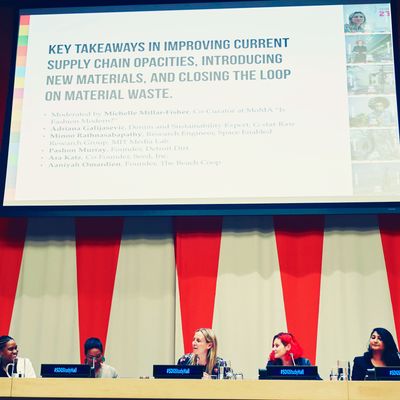
To kick off fashion month, which runs through February, the United Nations in New York hosted perhaps the most stylish group the U.N. has ever seen for a conference on sustainable and ethical fashion. The event, hosted by The Library and headed by activist Céline Semaan, featured six hours of talks and panels on the state of the industry and how fashion could become, well, better.
It was, at times, harrowing. Semaan, in her opening panel with sustainability/street-style expert Dio Kurazawa, questioned the use of organic cotton as a sustainable alternative, pointing to the stat that there’s 60 years of topsoil left for all harvest. As a result, the conference focused on reimagining the system. Semaan challenged the day’s attendees to think of waste as a resource for clothing and for fighting climate change. The speakers were eclectic, ranging from Enrica Arena, who turns wasted orange peels into silk, to Dapper Dan, and astronaut Leland Melvin. But all offered their own brand of tough love, balancing the challenges the industry is up against with galvanizing calls for change.
“It’s not just finding solutions for the sake of it, it’s working out the lead up to those problems and how we can deal with that as a bigger response,” Dr. Minoo Rathnasabapathy, a engineer with MIT Media Lab’s Space Enabled research group, said. A consensus was reached on a few ideas:
1) Finding ways to build a circular fashion economy is more important than ever. That means not only recycling or donating clothes, but recycling and donating clothes that have already been recycled and donated. “There’s no need for virgin materials,” Kurazawa said.
2) Waste is not trash, not in terms of clothes or anything else. Detroit Dirt founder Pashon Murray put it best, “Food waste is not waste — it’s a resource.”
3) The onus is on the industry, not the consumer, to change. The best thing for companies and influencers (who are crucial to building a more sustainable industry, according to Dapper Dan) to do is look at the industry as a system.
That’s the CliffsNotes version. The whole conference is archived on the U.N.’s website. But as we head into Fashion Week, it’s something to think about.




